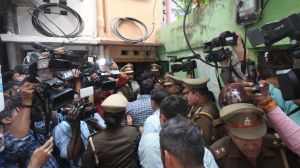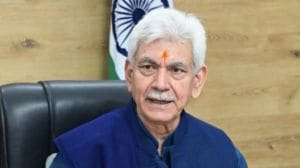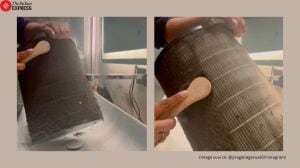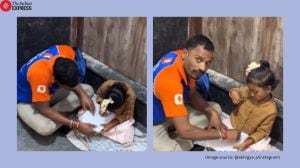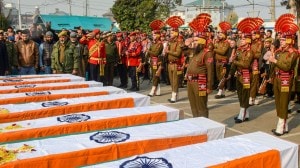Why Diwali is an annual date with ourselves and the world
It’s a time when we pause to appreciate the world at large and when we see everything we wish to cherish and preserve for ourselves and those who come after us
 Diwali tells the story of the victory of good over evil, hope over despair and love over hate. (Credit: Suvir Saran)
Diwali tells the story of the victory of good over evil, hope over despair and love over hate. (Credit: Suvir Saran) Diwali brings memories of delicious foods and visits with family and friends, festivities that give the air of Delhi a flavour unique to this moment in time, and guttural faith that makes us see light at the end of the darkest tunnel. It is a celebration that I cherish for its inclusive spirit and cheer. It comes with allegorical contexts that tell the story of the victory of good over evil, hope over despair and love over hate. It brings blood relatives together and gives society a collective moment of sharing and caring, it is an annual ritual that cleanses homes, bodies, minds and souls.
As I survey my life over the last year, I see every bit of the Diwali story come alive in different ways. All very real, all palpably plausible and all connected to my body, mind and soul. That I am now the culinary director of Bastian Hospitality Group in Mumbai is something I am most excited about and is a moment of celebration for me, professionally like nothing I could have imagined. Bastian has been the greatest restaurant success story in India. That I can now be part of their journey of hospitable growth, customer satisfaction, delicious discovery and lucrative success is a gift that I see as a perfect legacy project at age 50.
When I arrived in India more than a handful of years ago, back home in Delhi for the first time in over 25 years, I was hovering over the world of the doomed and dead. What little I saw with my one “good” eye was dark and unclear. My brain was dysfunctional and my body barely any better. My homecoming wasn’t that of fanfare and new beginnings; it was one of making peace with the most difficult of emotions, that of letting go, and even perhaps bidding goodbye. My life partner, my mother, siblings, and in-laws chose to have me in India for this difficult chapter of my life, one that could well have been its last.
But then Diwali happened to my sick body, and I was given a new lease on life. Magic, good luck and healing, miracles and the unwavering love of family and friends — these happened, and I live to tell the tale.
My mother, who is in her late 70s now, took my bout with physical malady as her call to action as a mother and a human. Her maternal instincts, her stoic calm garnered over decades of tutelage in the Bhagwada Gita, Vedas and Upanishads married to her wisdom and thoughtful alacrity, made her the fearless caregiver that the neurosurgeons in New York City and Delhi couldn’t imagine but wanted me to have. Restful healing, without societal or familial pressure, free of the burdens of professional demands — this sabbatical from the world of the living and functioning is what the good doctors hoped could be the salve my brain needed to heal. It was this safe cocoon that Mum afforded me without the slightest impression of worry on her face, in her voice or in the actions that occupied her round the clock.
This mother of mine has mothered countless many, mostly older than her, and some much younger, but for all, she has been there as the unsung hero who provided care without judgment, without the need for validation, and sometimes, despite the recipient meting out mean-spiritedness upon her for reasons of their own brokenness. In her service to the other, Mum found a connection to her inner goodness, a road to her own salvation as a human, and a way of being connected to the Atman, that spiritual essence of human beings.
Rising above fears that were seen by family and friends, Mum saw that the road was dark but at the end, was a bright and positive outcome. She knew I was giving up on life, despite our communication being very minimal due to my medical brokenness. She culled wisdom from intuition, left popular norms aside and sprang into action to provide for me and give me tangible hope. I was legally blind, with blood pressure so low that I had barely any resemblance to the larger-than-life creature that all saw me as, but Mum understood that cooking and travel, discovery and feeling wanted would drive me to believe that there was a life, where I still had a future full of hope and light, of growth and fulfilment.
From Mum’s mind to Smita and Rahul Bhatnagar’s world, I was presented with a cousin and sister-in-law who opened the home and kitchen to me. With Smita at my side, or rather me at her side, I would spend the better part of each day cooking and creating, chatting and fighting, feeding Rahul bhaiya and their kids and family and friends, and coming home bearing treats for Mum and the household. In India, in Smita’s home, with Mom’s confidence in knowing that I would heal even as I struggled to stay awake and not fall and hurt myself yet again as I battled low blood pressure, I slowly came back to life and the living. Each day with Smita, cooking and giving her lessons in world cuisine and nutritious cooking, I was doing what most inspires me: teaching. Through the motions of educating another, I gain knowledge, and this exchange has always been my most life-giving oxygen. Those kitchen lessons in Noida at the Bhatnagar home, over two-and-a-half delicious years, were the story of Diwali told through the actions of several kind, generous and magnanimous people. Because of them I was able to take a U-turn in the road to a place beyond that of merely existing, and in doing so, find my feet landing on more solid ground, where I became one with self because others believed in me, in the future, and their role in getting me there.
Diwali for me is a connection to history, lore and legend. It is also that annual date with ourselves, our families and communities and our fellow citizens of the world, where we see in each other a connecting link to our shared humanity. It’s a time when we pause to appreciate the world at large, when we see in the planet as a whole everything we wish to cherish and preserve for ourselves and those who come after us. Even as events are churning and we find ourselves in dark and dreary places, if we come together as a collective, we have the power to steer ourselves to a brighter future, full of rich hope and mindful tomorrows that can ensure that all of us shine and share in the harmonious magic that is the world when seen through the inclusive spirit of Diwali, the festival that marks the victory of good over evil and light over darkness as our shared heritage.
Mushroom Biryani by Suvir Saran
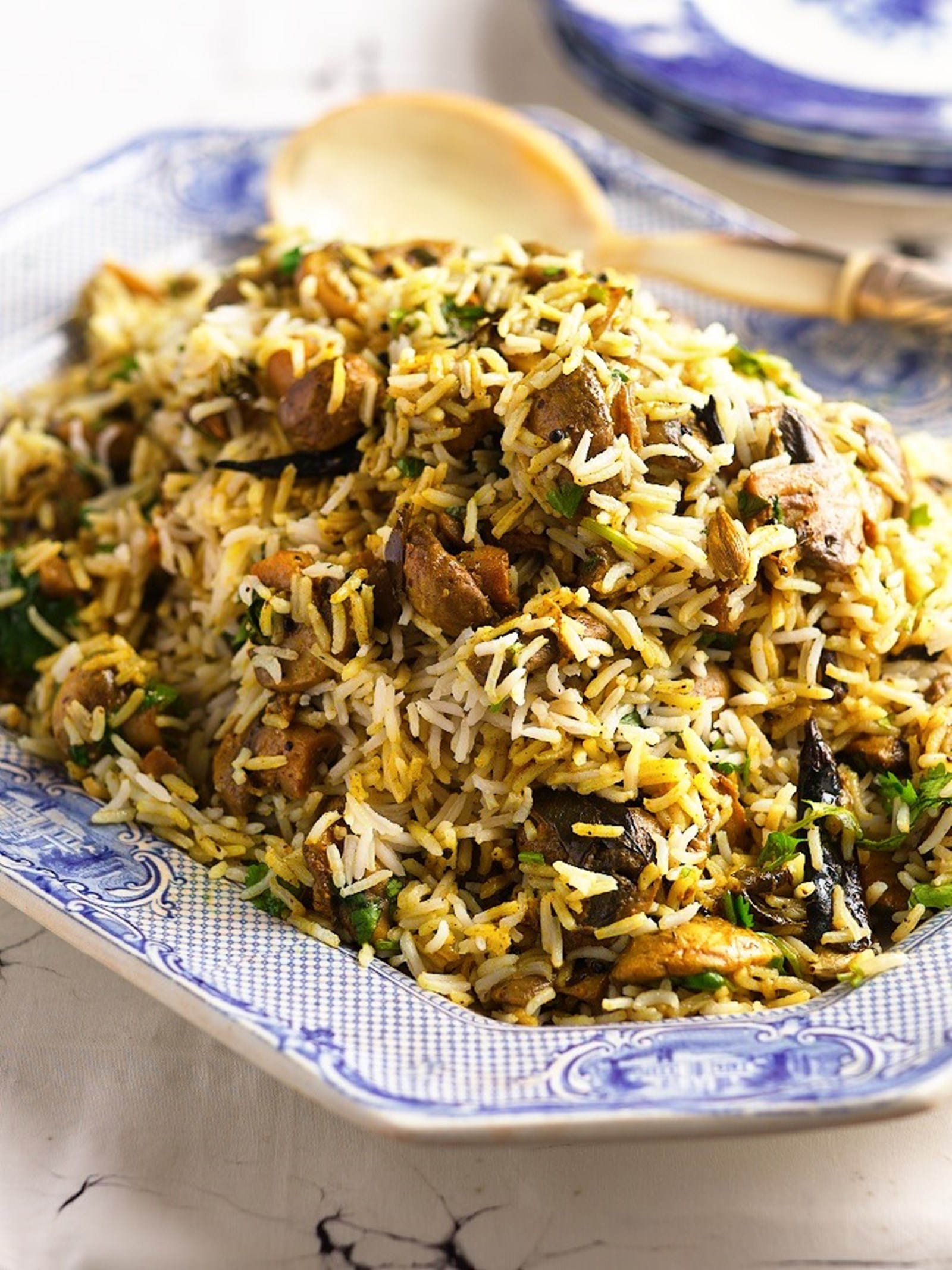 Recipe of Mushroom Biryani
Recipe of Mushroom Biryani
Serves 6 to 8
This is a vegetarian biryani purely of my own invention. It is perfect for festivals as there are no onions or tomatoes in it; its flavor is based solely on mushrooms and a south Indian palate of spices. For a more substantial meal, add one can or two cups of drained cooked chickpeas to the mushroom mixture. Serve this as a main course with pachadi/raita, or as a side dish. This biryani has turned many meat eaters into happy vegetarians.
For the rice
10 cups water
6 black peppercorns
4 whole cloves
4 green cardamom pods
2 bay leaves
1-inch piece cinnamon stick
2 cups basmati rice
For the mushroom mixture
1/4 cup canola oil
6 black peppercorns
6 green cardamom pods
3 whole cloves
1 tablespoon mustard seeds
1 teaspoon cumin seeds
36 curry leaves, roughly torn
1 to 6 dried red chiles
1 teaspoon turmeric
1 teaspoon ground coriander
1 kg white button mushrooms, trimmed and thickly sliced
2 teaspoons or more to taste, sea salt
1 teaspoon sambhar or 1/2 teaspoon curry powder
1 cup buttermilk
1/4 teaspoon cracked black peppercorns
1 tablespoon unsalted butter at room temperature
3/4 cup chopped coriander leaves
1/2 cup water
1. Bring the water, peppercorns, cloves, cardamom pods, bay leaves and cinnamon to a boil in a large pot. Add the rice and stir so it doesn’t stick to the bottom. Return to a boil and reduce heat to a vigorous simmer. Cook, partially covered for 6 minutes. Drain and set aside (you can pick out the whole spices if you like).
2. Heat your oven to 175°C or 350°F. Heat the oil, peppercorns, cardamom, cloves, mustard seeds and cumin in a large skillet or wok over medium-high heat cooking until the cumin is browned and the mustard seeds start to pop, about 1 1/2 to 2 1/2 minutes. Add the curry leaves, red chiles and the turmeric and cook, stirring often, for 1 minute. Reduce the heat to low, add the ground coriander and cook while stirring, until the red chiles are starting to darken, about 1 minute. Add the mushrooms and salt to the skillet and increase the heat to medium-high (the skillet will be full at this point). Cook, stirring often, until the mushrooms release their liquid, and the total volume of the mushrooms is reduced by about 1/2, about 4 to 5 minutes. Mix in the sambhar (or curry powder) and then stir in the buttermilk. Bring to a vigorous simmer and cook until the liquid is reduced by 1/2 and slightly thick, about 8 to 12 minutes (there will still be quite a bit of sauce). Stir in the cracked pepper and turn off the heat.
3. Grease a large 10-cup oven-safe casserole dish or Dutch oven (preferably one with a lid) with butter. Add 2 cups of the cooked rice, spreading it evenly over the bottom of the dish. Cover with 1/2 of the mushroom mixture and sprinkle with 1/3 of the coriander leaves. Evenly spread 1 1/2 cups of rice over the coriander and cover with the remaining mushrooms and 1/2 of the remaining coriander. Evenly spread the remaining rice on top and pour 1/2 cup of water around the edges of the dish. Cover tightly with aluminum foil, seal with a lid and bake for 35 minutes. Remove the casserole from the oven and let it stand 10 minutes. Uncover, sprinkle with the remaining coriander and serve.
PS: To make the recipe vegan, use coconut milk as a substitute for the dairy.
PS2: To make the biryanis in a lagan or degchi layer as you will for the casserole, seal the pan tightly with dough or foil. Cook on medium-low flame for 30-40 minutes, depending on the thickness of your pan and the strength of the flame. Turn flame off, rest for 10-15 minutes. Uncover, sprinkle with the remaining coriander and serve.





- 01
- 02
- 03
- 04
- 05








